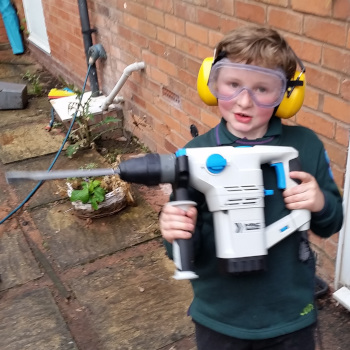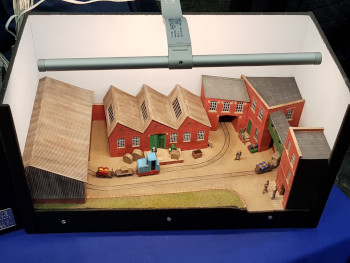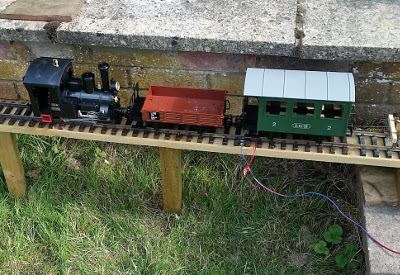- Home
- Learn Linux
- Learn Electronics
- Raspberry Pi
- Programming
- Projects
- LPI certification
- News & Reviews


25 November 2018
There are many different misconceptions about creating model railways and the people that are involved. I'd therefore like to start by dispelling some of these myths and explaining what I think that model railways is about.
Many people have come up with different rules for model railways, here's my take.
If you are wanting to design your own personal model railway then there are only three rules that you need to follow.
Okay, so that's only really 2 rules, but both are just as important. You also need a reason to be spending all that money, so I included fun as a third rule in the description below.
This is for your own railway on private land, but if you are on a public display then new rules apply - see Public Display Railways rules.
I think it's fairly obvious why rule number 1 exists, but remember this applies to both the modeling and the display of the model railway.
Who is going to view the railway and in what environment?
Have you checked there are no exposed live electrical components that could be a danger. For example check the plug is wired correctly and that there is no damage to the mains electrical cable. If it's an outdoor model railway then are all mains electrical parts suitably waterproof or located indoors?
If young children are going to be present then make sure they are no at risk of choking on small objects. In many cases this is best achieved through close supervision whilst they are viewing / interacting with the railway, but you may also want to consider adding a transparent plastic (perspex) screen to prevent them reaching the railway or designing a layout that is child friendly.

When modeling - do you know how to use the tools, are you following the manufacturer instructions and are you wearing appropriate PPE?
When dealing with small models then it's easy to make the mistake of thinking that the risks are also much smaller, but that is not the case. When using something like a rotary multi-tool / drill then the tools can be be spinning at thousands of revolutions per minute. If a small piece of metal or plastic is thrown out at that speed and hits your eye then it can result in permanent loss of sight. In fact due to the thickness of the cutting blades there is an increased risk of a blade breaking off and hitting you. I know that from experience (fortunately I was wearing eye protection at the time, but it could have been different).
If it's your railway then you can do what you want, which is to say that you make up your own rules of how you want the model railway to look. This is based on you wanting to create a railway for yourself. If you are wanting to participate in a club model or create a model for public exhibition then there may be other rules you need to apply, but when modeling for your own pleasure then you make up your own rules.
Why are you creating a model railway. For most of us it's because it's something you enjoy (or you want to try it and see if you enjoy it). Which comes back to rule number 2, you decide what the rules are that will make it enjoyable for you. If you can't afford to buy expensive scale models and want to include some cheap toys in your layout (Playmobil works very well with Garden Gauge Railways), or if you really want to incorporate something but it's not quite the same scale or a different era then do it. Feel free to do what you want and as long is it makes you happy then it's the right thing for you.
You may be under the impression that model railways are just for boys and men that still think they are kids, but that is not the case at all.
Model railways are good for all ages, from young children to great-grandparents,and ability. It's also just as much fun for girls, whether the girl is into science and engineering and likes those aspects of building a model railway, whether they are a historian and want to make it historically accurate or they prefer to make some kind of fantasy / science fiction world. There is not reason that model railway should be any less appealing to girls as it is to boys. There is something for everyone.

Sci-fi layout winner of the British Model Railway Challenge TV program.
The skills involved in creating a model railway depend upon the type of layout. They could vary from digging the garden and building a brick wall to support an outdoor railway, to painting N Scale model people that are only 1cm tall. There is lots of scope for STEM subjects such as electronics and mechanical engineering; all manner of art from creating scenery items or painting realistic backdrops; and a role for the historian to check on historical accuracy (if that's the type of layout you want).
Most model railway layouts attempt to create an element of realism, but if that's not your thing you could create a fantasy land with unicorns, sci-fi space planet or a scene from a horror movie, whatever direction your imagination takes you.
You may be thinking that you don't have the space for a model railway, but having seen some space constrained layouts I'm pretty sure that's not the case. Many OO scale layouts can fit comfortably under a single bed, N gauge is smaller still and I've seen an impressive 9mm narrow gauge layout which packed away inside a box smaller than a briefcase. T-scale is smaller still, although the tiny size of those models is a little too small for me (although amazing to see some of the models that some people have made). Just take a look at the photo below of one that I saw at the Warley Model Railway show 2018.

If you haven't got space in the house, then how about the garden (if you have one)? It's a great way to involve the whole family by choosing plants to grow next to the railway.
As I said the only really rules for your own railway are the ones you impose on yourself. I have put together a few guidelines that you may want to consider. Feel free to go against these guidelines if you have a reason for doing so.
These are three terms that are often used interchangeably, although there are some subtle differences. Scale refers to something having a direct correlation with real size (usually smaller). The difference in size of a scale model is normally expressed as a ratio, often following one of the common named ratios. The gauge is the distance between the track, but often scale and gauge are used interchangeably as the distance between the gauge is normally based on the same ratio as the scale for the models (though not always quite the same).
The standard gauge for British (and most other country) full size track is 4ft 8½in. Model railways are often based on a scaled down version of standard gauge. Some railways are closer together than standard gauge which is often known as narrow gauge or light-railways. These narrow gauge railways are popular for some railway modellers as they make good model layouts with only a few carriages. The ones marked in the table with an * are narrow gauge railways.
The table below shows some of the most common scales used for British and European model railways.
| Name | Ratio | Gauge | Comments |
|---|---|---|---|
| T scale | 1:480 | 3mm | This scale is unbelievably tiny. It does look good, but I expect is very difficult to model in. |
| N scale | 1:148 | 9mm | This is a common model railway for those looking for a smaller scale for 9mm. It can be particularly useful where you want to model a large layout, but don't have the space to create it in one of the larger scales.
|
| OO scale (Double Oh) | 1:76.2 | 16.5mm | The most common scale of model railway used within the UK. Ideal for use in a loft, garage or under the bed. The track size is the same as HO, but the scale used for models is slightly bigger making it a little out of the proper ration. |
| HO (Half-O) | 1:87 | 16.5mm | The most common size of model railway used in continental Europe. Similar to the OO standard and on the same width, but with a more realistic ratio. |
| O Scale | 1:45 | 32mm | A scale often used for larger scale models and for some outdoor railways. |
| 16mm Scale | 1:19.05 | Usualy 32mm * | Use for some narrow gauge outdoor model railways in the UK (less popular in Europe). |
| G Scale | 1:22.5 | 45mm * | Also known as garden gauge this is a popular scale for modeling narrow gauge railways that can be used outdoors. There is a wide variety of pre-built items available, although often these are based on European or Americal railways. |
| Gauge 1 | 1:32 | 45mm | Less common than G Scale these are standard gauge trains running on the same 45mm gauge as G scale. |
| Gauge 3 | 1:22.5 | 64mm | The same scale as G scale, but with wider gauge track for standard gauge trains. Needs a lot of space compared with the other scales listed. |
* These are the gauges used for narrow gauge tracks.
Some model railway enthusiasts are very strict in ensuring that where possible their model is true to their desired scale. It is however fairly common for some to use a similar scale when off-the-shelf models are not quite to the same scale. The use of HO and OO on some models where some scenic items intended for European countries are mixed with UK OO scale and a similar thing can happen with 16mm and G-Scale (although the track gauge is different the model scale is quite close).
Belos is an example of a narrow gauge - G-Scale railway.

Deciding upon a theme or year for the model railway to be based should be an early consideration. You should also decide on how important historical accuracy is to you.
This is perhaps one of the most controversial areas: the model railway purists may insist that you shouldn't include anything that doesn't comply with the historical accuracy at the time however having made an investment in a particular item then you may be keen to include that regardless of it's historical accuracy.
There are sometimes stories that you can use to incorporate the items from a different era. For example if you have a modern railway layout, but would like to include a steam locomotive then you could design in a preservation railway within the layout, or just give a story that it is a historical railway running on the mainline.
At the end of the day remember the three rules above. If you want to include it, but it doesn't fit with the accuracy then it's your railway and if you are enjoying creating it then it doesn't matter if it isn't historically accurate.
When buying a model then the chances are that it looks like a pristine brand new version. Weathering is the process of making a model look more realistic by making it look older and dirty. Not everything needs to be weathered as it's always possible that, if age appropriate, it really is a new locomotive just delivered from the factory. It's unlikely that all engines and buildings would look brand new.
On the other-hand some people may not want to spray dirty black / brown paint over their brand new model. If that's you then don't worry, just leave it as it is and accept how it looks.
When it comes to public displays then there are additional rules that you should follow. These apply whether the display is part of an exhibition, an outdoor public layout such as one at a preservation railway station or an open display on your own land. The main thing is an additional responsibility for health and safety and public liability insurance.
In addition the health and safety considerations already mentioned you may need to look at hazards around the site and periodic testing and certification of live steam engines. For electrical layouts you may need to consider PAT testing of electrical equipment that is in reach of visitors (or better still keep mains electricity away from the visitors).
Liability insurance is a requirement for public displays. If you are part of a model railway society check with them as they sometimes provide public liability if you have an "open day" at your own railway at your home. If not then make sure you take out insurance for a public event.
Thought should also be made about how accessible it is to disabled visitors as there may be a need to make reasonable adjustments for disabled access under the E qualities Act, particularly for a static display.
One final thing that I feel strongly about is swearing. If you are on a public display there should be no need to use bad language particularly when young children may be listening. This happened to me recently as we visited an outdoor model railway at a preservation railway station. One of the members there was talking with other members and used a completely inappropriate 4-letter word which was clearly audible to my son. Once may be a slip-up but then he repeated the same word again straight afterwards. It's a word that I certainly wouldn't ever use whilst with my children and was completely inappropriate.
There are very few rules beyond the need to keep yourself and others safe.
In my opinion having fun is much more important than realism or historical accuracy, but that is something you may want to think about when creating a layout for public display.